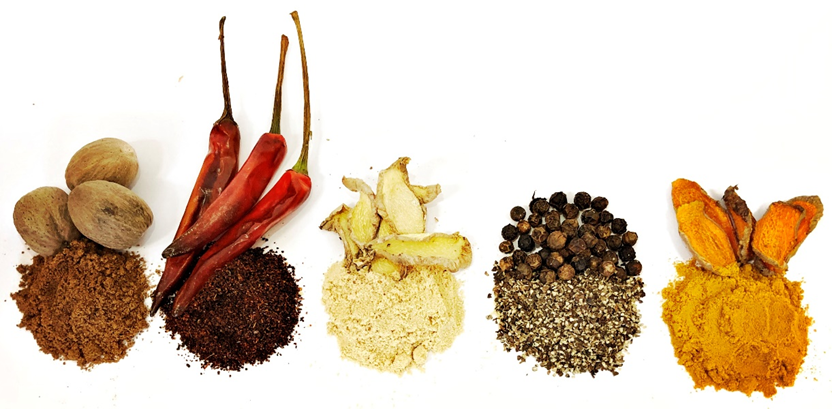
Food Safety Focus (155th Issue, June 2019) – Food Safety Platform
Mycotoxins in Spices
Reported by Ms. Janny MA, Scientific Officer
Risk Assessment Section, Centre for Food Safety
In the last two issues, we touched on several mycotoxins in food that present a health concern in humans, including aflatoxins in tree nuts and oil seeds, deoxynivalenol in cereals as well as patulin in apple juices. This time, we will focus on the contamination of mycotoxins in some other food ingredients that are often used in small quantities but can enhance flavours of our food – spices.

(From left to right) Dried or dehydrated nutmeg, chilli and paprika, ginger, pepper and turmeric have been reported to have higher susceptibility to mycotoxin contamination.
Spices and Mycotoxins
Humans have had a long history of using spices for making food aromatic, flavoursome and desirably seasoned. Spices include dried aromatic seeds, fruits, berries, bark, roots, rhizomes, buds and flowers from a variety of plants. They can be marketed in whole, ground, crushed or blended forms.
Spices are mostly produced in tropical areas that have high temperatures, high humidity and heavy rainfall. These climatic conditions favour mould growth and hence it is not surprising to find mycotoxins in spices.
Dried or dehydrated nutmeg, chilli and paprika, ginger, pepper and turmeric are the major spices traded globally and have been reported to be contaminated with higher amount of mycotoxins i.e. aflatoxins and ochratoxin A than other spices.
What is Ochratoxin A?
Ochratoxin A is produced by several mould species of Aspergillus and Penicillium. Apart from spices, ochratoxin A has been found in a variety of food commodities, such as cereals and cereal products, coffee beans and dried fruits. The most sensitive effect of ochratoxin A, notably, is kidney damage. Contrary to the clear evidence of causing cancer in animals, the association of ochratoxin A and cancer in humans remains unclear. The International Agency for Research on Cancer has classified ochratoxin A as a Group 2B agent (i.e. possibly carcinogenic in humans).
Possible Health Risk Associated with Mycotoxins in Spices
Even though relatively high levels of mycotoxin contamination may occur in spices, the dietary exposure of mycotoxins attributable to spices consumption is generally considered negligible, given that the amount of spices consumed is very low as compared with other food commodities. For instance, as revealed from the First Hong Kong Population-based Food Consumption Survey, the average daily consumption amount of various spices by the local population is around 0.3 g, which is much lower than that of rice at about 300 g.
Ways to Prevent and Reduce Mycotoxins in Spices
Due to the ubiquity of mould in nature, complete elimination of mycotoxins in food, including spices, might not be practical. To protect public health and ensure fair practices in the food trade, Codex is now establishing standards for mycotoxins in certain spices. Codex has also established a Code of Practice for the Prevention and Reduction of Mycotoxins in Spices for the trade's reference. Recommended practices include but not limited to (1) dry and process fresh materials for spices as quickly as possible after harvest; (2) dry spices properly to achieve a water activity below 0.65 – at this level, there would be hardly any mould growth and mycotoxin production; (3) pack dried or dehydrated spices, which tend to absorb moisture from the air (i.e. hygroscopic), quickly after processing using a material which shields the spices from moisture and (4) keep packaged commodities free of moisture or humidity.
For the public, they are advised to follow the storage instructions provided by the manufacturer, e.g. stored in a cool, dry, well-ventilated area, away from heat sources (e.g. ovens) and areas with high humidity, and avoid storing in a refrigerator to prevent condensation, etc. In addition, in order to prevent introduction and contamination of mould, the public should avoid contacting the whole lot of spices with wet utensils and wooden spoons. Immediately after use, containers should be closed tightly; unnecessary stockpiling should also be avoided.


